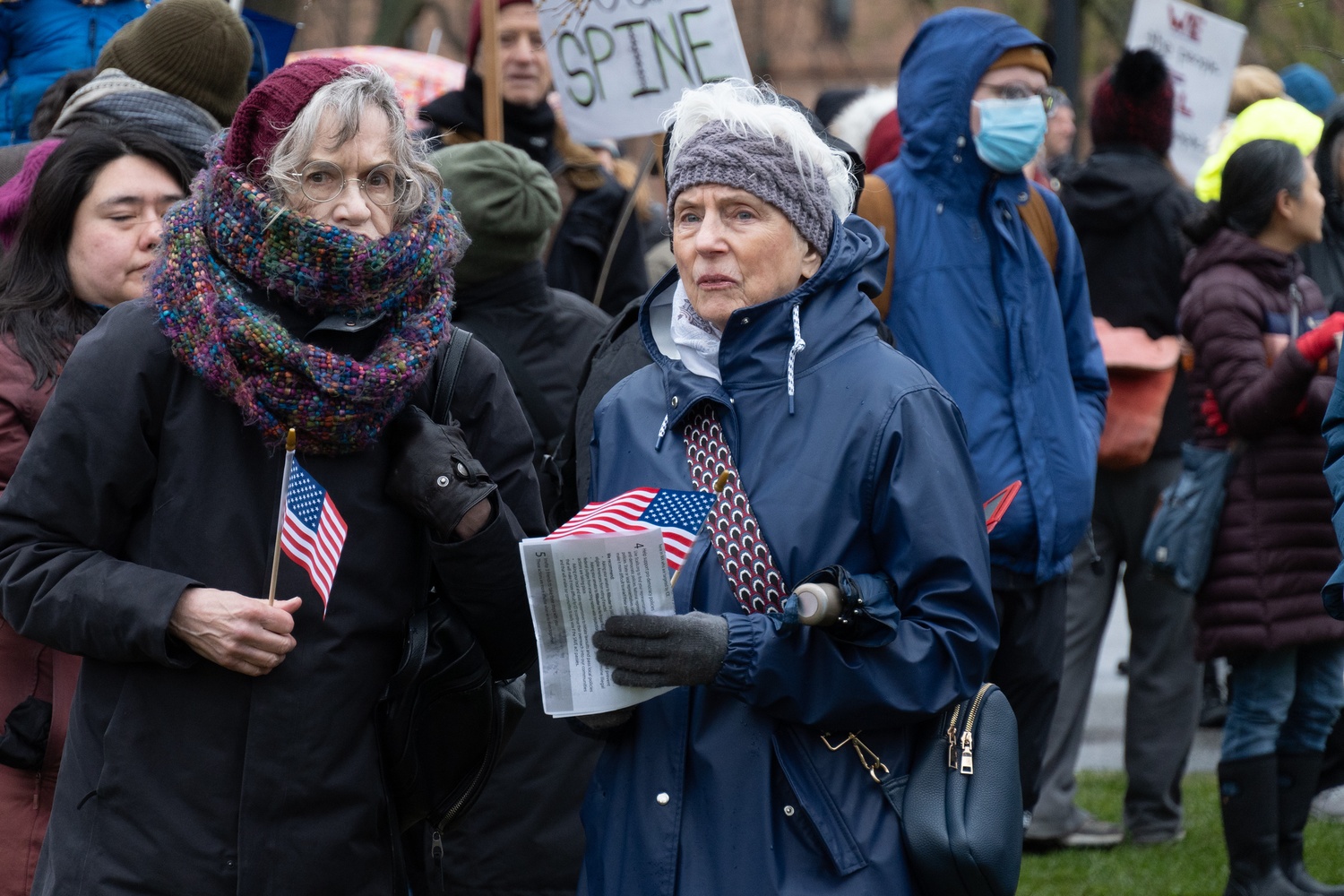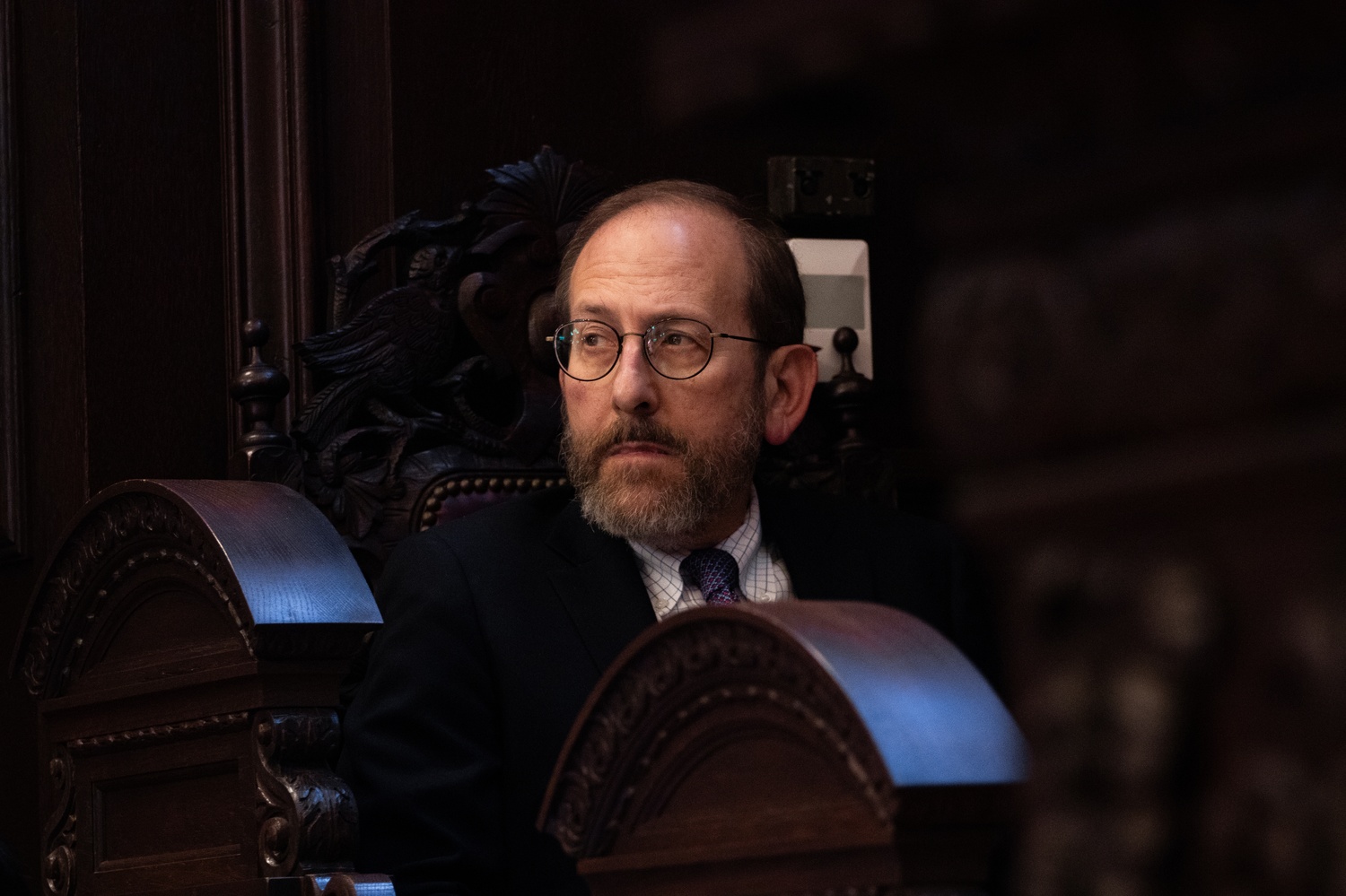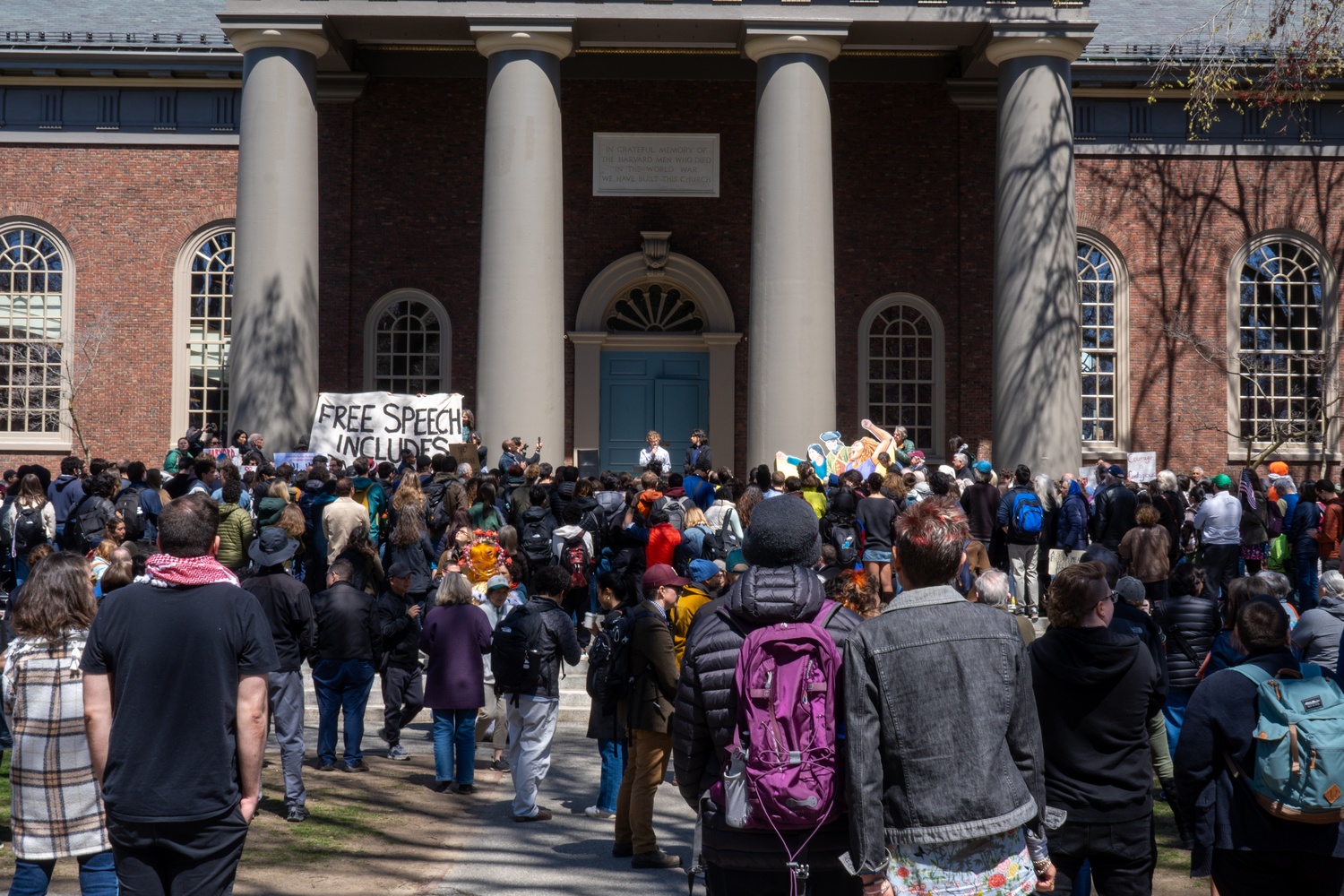Harvard’s Clash With Trump Raises Stakes — And Closes Doors
As Harvard’s multibillion dollar standoff with the Trump administration escalates, the University’s roads to retreat or reconciliation are narrowing.For two tense weeks in April, as the Trump administration kept $9 billion in Harvard’s federal funding in limbo, President Alan M. Garber ’76 said little of Harvard’s next move.
Top Harvard administrators gathered in Harvard Square just days after the demands were issued to mull over Harvard’s response — but left without a public decision.
Then, on Monday, Garber broke his silence.
He revealed that three days before, the White House had issued an expanded set of demands, which would have required Harvard to report international students who break University conduct rules to federal authorities, submit to three years of federal audits, and punish students for their involvement in pro-Palestine student groups.
Those conditions, Garber wrote in a University-wide message, were a bridge too far. He announced that Harvard would defy them — risking billions in federal funding, but heeding calls from students, faculty, and alumni to resist pressure from the federal government.
“No government — regardless of which party is in power — should dictate what private universities can teach, whom they can admit and hire, and which areas of study and inquiry they can pursue,” Garber wrote.
Garber’s message stunned Harvard — and left much of its campus briefly euphoric. With a firm new rallying cry, students and faculty were perhaps more united behind Garber than at any previous point in his tenure.
But the punishment was swift and relentless.
Less than seven hours after Garber’s message, federal agencies announced a freeze on more than $2.2 billion in multi-year grants and contracts to Harvard. The next day, President Donald Trump asked the Internal Revenue Service to make plans to revoke Harvard’s tax-exempt status.
On Wednesday, the Department of Homeland Security threatened to rescind Harvard’s eligibility to enroll international students. And on Thursday, a House committee demanded documents for a probe into Harvard’s refusal to abide by Trump’s demands.
As the week drew to a tumultuous close, international students hunkered down in labs and dorm rooms, fearing a crackdown. Researchers braced for disruptions — and layoffs.
Now, all eyes are on how Harvard will respond. Garber faces a high-stakes decision. He could quietly tolerate the funding cut and draw from Harvard’s more than $50 billion endowment to stay afloat. Or he could mount a legal challenge against the White House to rid the funding threat once and for all — even as Harvard shoulders the losses that are already mounting.
In either case, the contours of a long and costly battle are forming. And with Trump in office for the next three-and-a-half years, there may not be an end in sight.
Harvard Prepares for a Fight
Until Garber’s statement on Monday, Harvard’s campus was jittery and divided. After Columbia University conceded to similar demands from the government in March, Harvard faculty and students wondered whether their own school would be the next domino to fall.
A series of administrative decisions that mirrored the changes at Columbia — including the ouster of leaders at the Center for Middle Eastern Studies and the dismantling of a Harvard Divinity School program on religion and conflict — were seen by many students and faculty as obedience in advance, designed to placate Republicans and prevent them from making Harvard their next target.
As all of Harvard waited for Garber to respond to Trump’s ultimatum, activists mounted a pressure campaign to convince the University to fight rather than fold. Local stakeholders — including the Cambridge City Council and Harvard’s chapter of the American Association of University Professors — circulated petitions and held a hundreds-strong protest in Cambridge Common.

Even so, Monday’s announcement was unexpected when it arrived. Quickly, though, it became a call to arms on campus.
Eric D. Hwang ’25 said on Monday that Garber’s decision “made me feel really proud to be a Harvard student.” Praise for Garber flooded the airwaves on Sidechat, an anonymous social media platform for students. And the same faculty who had protested Harvard’s earlier decisions planned a rally to “applaud” Garber’s statement.
Even the Harvard Square burger joint Bartley’s advertised a new menu item on a sandwich board on Mass. Ave.: the “ballsy Harvard.”
But even as Harvard’s stand spurred unity and pride on campus, it did not take long for the University to begin feeling the pain of the multi-agency fusillade Republicans mobilized against it.
The effects of the $2.2 billion funding cut rapidly began appearing across campus. Less than one day after the White House announced the cut, Harvard-affiliated researchers began receiving stop-work orders on contracts worth tens of millions of dollars.
Plans to downsize were also announced across Harvard’s campus.
On Wednesday, Harvard Medical School leadership told researchers and professors at a closed-door town hall to expect “permanent layoffs,” according to a recording obtained by The Crimson.
Layoffs had already begun by Thursday at the Harvard School of Public Health, where faculty have been told to expect significant changes to programming in the wake of a “significant budget crisis.”
The changes were tied to earlier funding losses — grants cut because they clashed with Trump’s agenda, stalled review processes for new federal research dollars — but they provided a grim preview of how Harvard’s operations could shudder under the weight of massive, targeted cuts.
So far, the sweeping effects have galvanized Harvard affiliates, rather than discouraging them.
University Professor emeritus Laurence H. Tribe ’62 said that some faculty members have indicated to Harvard administrators that they would take a cut in their salaries provided that the saved funds would support research projects in limbo.
And within 24 hours of Garber’s message on Monday, Harvard raked in more than $1 million through 3,800 online donations from alumni — more than 40 times the University’s average daily intake in April.
In the hours after the White House announced the $2.2 billion funding pause, contributions to Harvard spiked — even more than they did when Garber’s email first landed in alumni inboxes.
A National Movement
Harvard did not plan to carry the banner for higher education’s resistance to Trump.
University leaders indicated in February that they would pick their battles — saying they were inclined to band together with other schools and under umbrella organizations, rather than leading the charge alone.
But the forceful symbolism of Harvard’s resistance on Monday provoked a tidal shift in higher education, where leaders at the nation’s most prominent universities had previously been reluctant to challenge the White House.
Stanford University chose swiftly to publicly stand behind Harvard, with its leaders condemning Trump’s show of force and praising Harvard’s resistance.
“Harvard’s objections to the letter it received are rooted in the American tradition of liberty,” the school’s president and provost wrote in a statement to the Stanford Daily on Monday.

And on Monday, Columbia — whose earlier capitulation had inaugurated a bleak mood across academia — issued a striking about-face, declaring that Columbia would resist “heavy-handed orchestration” from the government. Though the university’s acting president, trustee Claire Shipman, defended the concessions Columbia made in March, she wrote that the school would “reject any agreement in which the government dictates what we teach, research, or who we hire.”
Garber’s refusal, it seemed, had given universities a new path forward. No longer was appeasing Trump a necessary strategy — or even a viable message.
A day after Columbia’s statement, more than 70 former and current university presidents released a message affirming Garber’s refusal to comply with the administration’s demands.
It was signed by former presidents from Columbia, Dartmouth College, and the University of Pennsylvania — and Drew G. Faust, who led Harvard through the start of Trump’s first term.
“When the Trump administration insists on anyone’s compliance with likely illegal and unconstitutional conditions, it is threatening everyone’s freedom from arbitrary rule,” read the statement.
Too Far To Fold?
Garber’s Monday message framed the dispute with the Trump administration as a matter of Harvard’s First Amendment rights, arguing that the government’s demands were aimed at controlling academic life — not at combating antisemitism.
At the same time, he did not take compromise entirely off the table.
In a letter to federal agencies on Monday, the University’s lawyers highlighted changes they said it had made to fight antisemitism and promote ideological diversity — including new restrictions on gatherings and signage and the suspension of Harvard’s partnership with Birzeit University in the West Bank.
“Harvard remains open to dialogue about what the university has done, and is planning to do, to improve the experience of every member of its community,” the lawyers wrote.

But the torrent of measures Republicans have taken against Harvard in the past week makes reconciliation significantly less likely. Not only have lawmakers intensified their demands, they have also taken direct steps to further restrict Harvard’s academic life — making it clear that punishing ideology is the point.
While Garber accused the Trump administration of using federal power to punish academic dissent, Republicans have openly embraced that framing — arguing that Harvard’s research priorities and culture are at odds with American values.
The DHS demanded protest-related records for international students, the IRS drafted plans to revoke Harvard’s tax-exempt status, and high-profile House Republicans launched a civil rights probe. In justifying the revocation of two DHS grants, Secretary of Homeland Security Kristi Noem argued that they “funded Harvard’s public health propaganda” and supported research that “branded conservatives as far-right dissidents.”

Even before the Trump administration’s advances, Garber made the case that the federal government was overstepping its authority, writing that the language of the letter to Harvard made its ideological aims plain.
A retreat now would risk validating the very pressure that Garber condemned on Monday. His refusal to comply has made Harvard the national poster child for elite university defiance — but it has also made retreat more difficult, with no easy off-ramp.
Now, Harvard’s leaders are no longer simply faced with the question of whether to respond to Trump — but how far they are willing to go, and what costs they are ready to bear.
—Staff writer Dhruv T. Patel can be reached at dhruv.patel@thecrimson.com. Follow him on X @dhruvtkpatel.
—Staff writer Grace E. Yoon can be reached at grace.yoon@thecrimson.com. Follow her on X @graceunkyoon.

